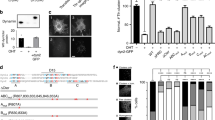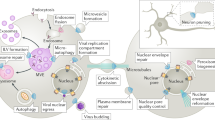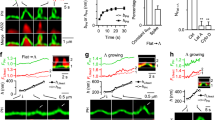Abstract
Membrane fission is a fundamental step in membrane transport. So far, the only fission protein machinery that has been implicated in in vivo transport involves dynamin, and functions in several, but not all, transport pathways. Thus, other fission machineries may exist. Here, we report that carboxy-terminal binding protein 3/brefeldin A-ribosylated substrate (CtBP3/BARS) controls fission in basolateral transport from the Golgi to the plasma membrane and in fluid-phase endocytosis, whereas dynamin is not involved in these steps. Conversely, CtBP3/BARS protein is inactive in apical transport to the plasma membrane and in receptor-mediated endocytosis, both steps being controlled by dynamin. This indicates that CtBP3/BARS controls membrane fission in endocytic and exocytic transport pathways, distinct from those that require dynamin.
This is a preview of subscription content, access via your institution
Access options
Subscribe to this journal
Receive 12 print issues and online access
$209.00 per year
only $17.42 per issue
Buy this article
- Purchase on Springer Link
- Instant access to full article PDF
Prices may be subject to local taxes which are calculated during checkout






Similar content being viewed by others
References
Corda, D., Hidalgo Carcedo, C., Bonazzi, M., Luini, A. & Spano, S. Molecular aspects of membrane fission in the secretory pathway. Cell. Mol. Life Sci. 59, 1819–1832 (2002).
Praefcke, G.J. & McMahon, H.T. The dynamin superfamily: universal membrane tubulation and fission molecules? Nature Rev. Mol. Cell Biol. 5, 133–147 (2004).
Pelkmans, L. & Helenius, A. Insider information: what viruses tell us about endocytosis. Curr. Opin. Cell Biol. 15, 414–422 (2003).
Altschuler, Y. et al. Redundant and distinct functions for dynamin-1 and dynamin-2 isoforms. J. Cell Biol. 143, 1871–1881 (1998).
Gurunathan, S., David, D. & Gerst, J.E. Dynamin and clathrin are required for the biogenesis of a distinct class of secretory vesicles in yeast. EMBO J. 21, 602–614 (2002).
Harsay, E. & Schekman, R. A subset of yeast vacuolar protein sorting mutants is blocked in one branch of the exocytic pathway. J. Cell Biol. 156, 271–285 (2002).
Luo, W. & Chang, A. An endosome-to-plasma membrane pathway involved in trafficking of a mutant plasma membrane ATPase in yeast. Mol. Biol. Cell 11, 579–592 (2000).
Conner, S.D. & Schmid, S.L. Regulated portals of entry into the cell. Nature 422, 37–44 (2003).
McNiven, M.A., Cao, H., Pitts, K.R. & Yoon, Y. The dynamin family of mechanoenzymes: pinching in new places. Trends Biochem. Sci. 25, 115–120 (2000).
Schmid, S.L., McNiven, M.A. & De Camilli, P. Dynamin and its partners: a progress report. Curr. Opin. Cell Biol. 10, 504–512 (1998).
Yeaman, C. et al. Protein kinase D regulates basolateral membrane protein exit from trans-Golgi network. Nature Cell Biol. 6, 106–112 (2004).
Weigert, R. et al. CtBP/BARS induces fission of Golgi membranes by acylating lysophosphatidic acid. Nature 402, 429–433 (1999).
Matsuoka, K. et al. COPII-coated vesicle formation reconstituted with purified coat proteins and chemically defined liposomes. Cell 93, 263–275 (1998).
Bremser, M. et al. Coupling of coat assembly and vesicle budding to packaging of putative cargo receptors. Cell 96, 495–506 (1999).
Bigay, J., Gounon, P., Robineau, S. & Antonny, B. Lipid packing sensed by ArfGAP1 couples COPI coat disassembly to membrane bilayer curvature. Nature 426, 563–566 (2003).
Yang, J.S. et al. ARFGAP1 promotes the formation of COPI vesicles, suggesting function as a component of the coat. J. Cell Biol. 159, 69–78 (2002).
Spano, S. et al. Molecular cloning and functional characterization of brefeldin A-ADP-ribosylated substrate. A novel protein involved in the maintenance of the Golgi structure. J. Biol. Chem. 274, 17705–17710 (1999).
Hidalgo Carcedo, C. et al. Mitotic Golgi partitioning is driven by the membrane-fissioning protein CtBP3/BARS. Science 305, 93–96 (2004).
Nardini, M. et al. CtBP/BARS: a dual-function protein involved in transcription co-repression and Golgi membrane fission. EMBO J. 22, 3122–3130 (2003).
Kumar, V. et al. Transcription corepressor CtBP is an NAD(+)-regulated dehydrogenase. Mol. Cell 10, 857–869 (2002).
Chinnadurai, G. CtBP, an unconventional transcriptional corepressor in development and oncogenesis. Mol. Cell 9, 213–224 (2002).
Polishchuk, E.V., Di Pentima, A., Luini, A. & Polishchuk, R.S. Mechanism of constitutive export from the Golgi: bulk flow via the formation, protrusion, and en bloc cleavage of large trans-Golgi network tubular domains. Mol. Biol. Cell 14, 4470–4485 (2003).
Boulan, E.R. & Pendergast, M. Polarized distribution of viral envelope proteins in the plasma membrane of infected epithelial cells. Cell 20, 45–54 (1980).
Matlin, K.S. & Simons, K. Reduced temperature prevents transfer of a membrane glycoprotein to the cell surface but does not prevent terminal glycosylation. Cell 34, 233–243 (1983).
Hirschberg, K. et al. Kinetic analysis of secretory protein traffic and characterization of Golgi to plasma membrane transport intermediates in living cells. J. Cell Biol. 143, 1485–1503 (1998).
Polishchuk, R., Pentima, A.D. & Lippincott-Schwartz, J. Delivery of raft-associated, GPI-anchored proteins to the apical surface of polarized MDCK cells by a transcytotic pathway. Nature Cell Biol. 6, 297–307 (2004).
Polishchuk, R.S. et al. Correlative light-electron microscopy reveals the tubular-saccular ultrastructure of carriers operating between Golgi apparatus and plasma membrane. J. Cell Biol. 148, 45–58 (2000).
Kasai, K., Shin, H.W., Shinotsuka, C., Murakami, K. & Nakayama, K. Dynamin II is involved in endocytosis but not in the formation of transport vesicles from the trans-Golgi network. J. Biochem. (Tokyo) 125, 780–789 (1999).
Cao, H., Thompson, H.M., Krueger, E.W. & McNiven, M.A. Disruption of Golgi structure and function in mammalian cells expressing a mutant dynamin. J. Cell Sci. 113, 1993–2002 (2000).
Jones, S.M., Howell, K.E., Henley, J.R., Cao, H. & McNiven, M.A. Role of dynamin in the formation of transport vesicles from the trans-Golgi network. Science 279, 573–577 (1998).
Kreitzer, G., Marmorstein, A., Okamoto, P., Vallee, R. & Rodriguez-Boulan, E. Kinesin and dynamin are required for post-Golgi transport of a plasma-membrane protein. Nature Cell Biol. 2, 125–127 (2000).
Keller, P., Toomre, D., Diaz, E., White, J. & Simons, K. Multicolour imaging of post-Golgi sorting and trafficking in live cells. Nature Cell Biol. 3, 140–149 (2001).
Schalk, E.M., Gosiewska, A., Prather, W. & Peterkofsky, B. Post-transcriptional regulation of the pro alpha 1(I) collagen gene in pro alpha 1(I)-deficient, chemically transformed Syrian hamster embryo fibroblasts. Biochem. Biophys. Res. Commun. 188, 780–785 (1992).
Damke, H., Baba, T., Warnock, D.E. & Schmid, S.L. Induction of mutant dynamin specifically blocks endocytic coated vesicle formation. J. Cell Biol. 127, 915–934 (1994).
Sabharanjak, S., Sharma, P., Parton, R.G. & Mayor, S. GPI-anchored proteins are delivered to recycling endosomes via a distinct cdc42-regulated, clathrin-independent pinocytic pathway. Dev. Cell 2, 411–423 (2002).
Guha, A., Sriram, V., Krishnan, K.S. & Mayor, S. Shibire mutations reveal distinct dynamin-independent and -dependent endocytic pathways in primary cultures of Drosophila hemocytes. J. Cell Sci. 116, 3373–3386 (2003).
Griffiths, G., Pfeiffer, S., Simons, K. & Matlin, K. Exit of newly synthesized membrane proteins from the trans cisterna of the Golgi complex to the plasma membrane. J. Cell Biol. 101, 949–964 (1985).
Hildebrand, J.D. & Soriano, P. Overlapping and unique roles for C-terminal binding protein 1 (CtBP1) and CtBP2 during mouse development. Mol. Cell Biol. 22, 5296–5307 (2002).
Zhang, Q., Piston, D.W. & Goodman, R.H. Regulation of corepressor function by nuclear NADH. Science 295, 1895–1897 (2002).
Pagano, M. & Jackson, P.K. Wagging the dogma; tissue-specific cell cycle control in the mouse embryo. Cell 118, 535–538 (2004).
Sage, J., Miller, A.L., Perez-Mancera, P.A., Wysocki, J.M. & Jacks, T. Acute mutation of retinoblastoma gene function is sufficient for cell cycle re-entry. Nature 424, 223–228 (2003).
Kantheti, P. et al. Mutation in AP-3 delta in the mocha mouse links endosomal transport to storage deficiency in platelets, melanosomes, and synaptic vesicles. Neuron 21, 111–122 (1998).
Di Paolo, G. et al. Decreased synaptic vesicle recycling efficiency and cognitive deficits in amphiphysin 1 knockout mice. Neuron 33, 789–804 (2002).
Cremona, O. et al. Essential role of phosphoinositide metabolism in synaptic vesicle recycling. Cell 99, 179–188 (1999).
Sutterlin, C., Hsu, P., Mallabiabarrena, A. & Malhotra, V. Fragmentation and dispersal of the pericentriolar Golgi complex is required for entry into mitosis in mammalian cells. Cell 109, 359–369 (2002).
Nardini, M. et al. Crystallization and preliminary X-ray diffraction analysis of brefeldin A-ADP ribosylated substrate (BARS). Acta Crystallogr. D Biol. Crystallogr. 58, 1068–1070 (2002).
Liou, W., Geuze, H.J. & Slot, J.W. Improving structural integrity of cryosections for immunogold labeling. Histochem. Cell Biol. 106, 41–58 (1996).
Mironov, A.A. et al. Small cargo proteins and large aggregates can traverse the Golgi by a common mechanism without leaving the lumen of cisternae. J. Cell Biol. 155, 1225–1238 (2001).
Acknowledgements
The authors would like to thank M. A. De Matteis for critical reading of the manuscript; M. McNiven, M. A. De Matteis and S. Ponnambalam for antibodies; F. Mirabella for supplying constructs; C. P. Berrie for editorial assistance; and the Italian Association for Cancer Research (AIRC, Milan, Italy), Telethon Italia, and the Ministero dell'Istruzione, dell'Università e della Ricerca (MIUR, Italy) for financial support. M.B. and S.S. are fellows of the Italian Foundation for Cancer Research (FIRC, Milan, Italy). This paper is dedicated to the memory of Julius Axelrod.
Author information
Authors and Affiliations
Corresponding author
Ethics declarations
Competing interests
The authors declare no competing financial interests.
Supplementary information
Supplementary information
Supplementary figures S1, S2, S3, S4 and movie legends (PDF 542 kb)
Rights and permissions
About this article
Cite this article
Bonazzi, M., Spanò, S., Turacchio, G. et al. CtBP3/BARS drives membrane fission in dynamin-independent transport pathways. Nat Cell Biol 7, 570–580 (2005). https://doi.org/10.1038/ncb1260
Received:
Accepted:
Published:
Issue Date:
DOI: https://doi.org/10.1038/ncb1260
This article is cited by
-
CtBP Neuroprotective Role in Toxin-Based Parkinson’s Disease Models: From Expression Pattern to Dopaminergic Survival
Molecular Neurobiology (2023)
-
ALDH7A1 inhibits the intracellular transport pathways during hypoxia and starvation to promote cellular energy homeostasis
Nature Communications (2019)
-
Clathrin-independent endocytosis: an increasing degree of complexity
Histochemistry and Cell Biology (2018)
-
Coupling fission and exit of RAB6 vesicles at Golgi hotspots through kinesin-myosin interactions
Nature Communications (2017)
-
Golgi membrane fission requires the CtBP1-S/BARS-induced activation of lysophosphatidic acid acyltransferase δ
Nature Communications (2016)



